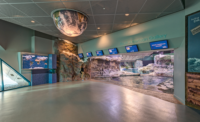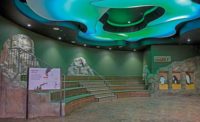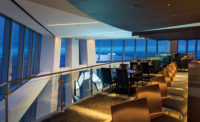Polk Penguin Conservation Center at the Detroit Zoo
Detroit
Region Midwest
Sports/Entertainment
Project Team
Owner Detroit Zoological Society
Architect Albert Kahn Associates Inc.
Contractor DeMaria/Wharton-Smith JV
Engineers Alfred Benesch & Co. (Tucker, Young, Jackson, Tull Inc.) and Albert Kahn Associates Inc.
Consultant T.A. Maranda Consultants Inc.
DeMaria, the lead contractor for the world’s deepest-dive penguinarium, constructed various animal habitats for the Detroit Zoological Society over 15 years. Still, working on a deepwater facility, the firm knew from the start that it was in over its head. So, it dove into the project with a partner, Wharton-Smith, which had built various water attractions in Florida.
“It was a perfect fit,” says Darren Murray, DeMaria’s executive vice president. “We provided the relationship with the Detroit Zoo and the know-how to build through the cold winter, and Wharton-Smith provided the experience with aquatics construction,” he adds. “It was great synergy.”
The $29-million center, which opened last April, is home to more than 80 penguins from four species: gentoo, macaroni, rockhopper and king. With its 326,000-gallon tank, which allows penguins to dive as deep as 25 ft, the conservation center is the largest of its type in the world. The tank was waterproofed both inside and out. To check for leaks, crews filled it with water for 24 hours.
Two acrylic underwater tunnels, which collectively weigh more than 16.5 tons, provide visitors with views of penguin activities on three and even four sides.
Inspired by the legendary Antarctic expeditions of Sir Ernest Shackleton and using biomimicry, the angular exterior was designed to resemble a tabular iceberg, with a 25-ft-tall waterfall in a narrow crevasse. The skin, a rain-screen system of overlapping “scales,” insulation and an air layer, functions like a penguin’s feather coat.
Heat gain and loss had to be studied in 3D form because the interior is like a freezer, says Alan Cobb, president and CEO of Albert Kahn Associates, who calls the job one of the most exciting and challenging in his 40 years in architecture. The refrigerated building, which has systems that maintain a 37°F temperature for the animals and a comfortable climate for humans, is a “very elaborate machine,” says Cobb.
Constructing the themed environment, which contains faux ice, rock and snow formations, took seven months. The formations are shaped by reinforcing steel covered by shotcrete.
Building the entire project wasn’t simple, but Murray says one of the most demanding dynamics of the job—with a site just inside the zoo’s main entrance—was providing opportunities for the public to watch the work, as if it were an exhibit. Murray calls it “interactive separation.” At the same time, the team had to keep safe the zoo’s millions of annual visitors.
Working in a fishbowl, the team created transparent viewing bubbles—at different heights for different age groups—in the construction wall. In addition, inside the perimeter of the two-acre site, the zoo sometimes hosted fund-raising events, which shut down construction. For the fund-raisers, workers built a series of temporary viewing platforms.
Thanks to the interactive separation, communication throughout the project was even more critical than on most jobs. The safety program, which included detailed logistical plans for materials deliveries, extended beyond the project to embrace the zoo staff and visitors.
The zoo is using the penguinarium to educate visitors about the effects of climate change. In addition to the penguin and human life-support systems, the building has many green features. The goal is for net-zero annual water use through the reclamation and treatment of the habitat and animal-management pools, wash-down systems and the exterior splash area. Skylights allow ultraviolet light to enhance the penguins’ health.
“It is a pretty amazing project,” says one judge, who called the quality of the design and the challenges of construction “remarkable.”
After a year of occupancy, commissioning is ongoing to fine-tune the operations, but the building is working well, says Cobb.
The penguin house “opened to rave reviews and has made the Detroit Zoo one of the top 10 destinations in the nation,” adds Cobb. “People are coming to Detroit just to see the penguin exhibit.”










